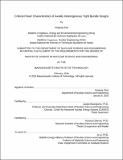Critical power characteristics of axially heterogeneous tight bundle designs
Author(s)
Zhao, Xingang,Ph.D.Massachusetts Institute of Technology.
DownloadFull printable version (3.142Mb)
Other Contributors
Massachusetts Institute of Technology. Department of Nuclear Science and Engineering.
Advisor
Jacopo Buongiorno and Koroush Shirvan.
Terms of use
Metadata
Show full item recordAbstract
Accurate prediction of the dryout critical power in fuel rod bundles is challenging and has important implications for the economy and safety of Boiling Water Reactors (BWRs). This is especially true for the tight bundle design of the Resource-Renewable BWR (RBWR) proposed by Hitachi, Ltd. Unlike a traditional square lattice BWR fuel bundle, the RBWR bundle is a relatively short tight hexagonal lattice with axially heterogeneous fuel composition for purpose of providing actinide breeding and burning capabilities. The RBWR's different core geometry, combined with higher power-to-flow ratio and larger coolant void fraction, demands a reevaluation of the standard BWR thermal hydraulic models. One of the key constraints in BWR design is the thermal margin to dryout occurrence, referred to as the Minimum Critical Power Ratio (MCPR). In this thesis, different approaches for predicting critical power of tight bundles are investigated through empirical and mechanistic formulations. Previous work at MIT focused on collecting dryout database representative of RBWR fuel bundle geometry and operating conditions, and derived a best-estimate model for the prediction of critical quality/power, named M1-CISE4 (modified CISE4 version 1) correlation, which was based on the CISE4 formulation. This model showed significant scatter when compared to experimental data in its range of validity. This work supplements tight bundle data with relevant critical heat flux (CHF) data for tubes and annuli to better understand the effect of different parameters. An updated correlation, M2-CISE4 (modified CISE4 version 2), is proposed and analyses reveal that the dependence of critical power on such parameters as non-uniform axial and radial power distribution profiles as well as heated length requires further investigations via sub-channel analysis, using the code VIPRE-01. Results of radial quality distribution at the axial location of dryout are then incorporated and yield the M3-CISE4 (modified CISE4 version 3) correlation development. Another approach utilized in the prediction of dryout databases is the three-field model, which relies on a mechanistic system of mass balance equations to resolve relevant fields (liquid film, entrained droplets, and vapor) within the annular flow regime. The introduction of sub-channel analysis is able to reduce the predicted standard deviation with both M3-CISE4 and three-field model against tight bundle database that includes eight different data sets with a total of 565 measurements with various axial and radial power distributions. Lastly, the MCPR evaluation of the two current RBWR designs, RBWR-AC and TB2, is performed using the models above and values are compared against the conventional BWR steady-state design limit.
Description
Thesis: S.M., Massachusetts Institute of Technology, Department of Nuclear Science and Engineering, 2016. This electronic version was submitted by the student author. The certified thesis is available in the Institute Archives and Special Collections. Cataloged from student-submitted PDF version of thesis. Includes bibliographical references (pages 133-136).
Date issued
2016Department
Massachusetts Institute of Technology. Department of Nuclear Science and EngineeringPublisher
Massachusetts Institute of Technology
Keywords
Nuclear Science and Engineering.